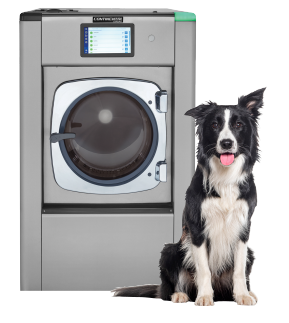Veterinary clinics and hospitals work hard to eliminate the spread of disease through cross-contamination. Laundry items with birthing fluids, blood, urine, feces, or any other body fluids can spread disease to other animals, areas of the operation or even to staff. Disease-causing bacteria, such as Salmonella, E. coli, and Campylobacter are a few examples. That’s why it’s critical to handle, process and sanitize soiled laundry — bedding, towels, blankets, mop heads and rags — appropriately. Read on for laundry processing best practices.
1. Wear proper PPE, gloves, gowns, face and eye protection when handling soiled (contaminated) washables. Eliminate the spread of infection from the beginning by PPE when handling laundry. Be sure you have a separate bin for soiled laundry and clean laundry. Sanitize those bins regularly.
2. Don’t allow contaminated laundry to pile up. Clean and sanitize it immediately. If you struggle to keep pace with incoming soiled laundry, solutions include bagging or moving into a larger capacity washer or replacing an existing washer with a similarly sized soft-mount machine with higher extract capability. Washers with extract speeds up to 450 G-force can reduce drying time by up to 50 percent because they remove more moisture from linens. This allows vet clinics to complete significantly more laundry in less time.
3. Use a highly programmable washer-extractor with automatic chemical injection. In doing so, cleaning and disinfection programs can be established for towels, pet bedding, rags, blankets and mopheads by your chemical provider. Once the programs are set, the machine automatically adjusts water temperature and levels, number of baths and rinses, with the perfect chemistry/ozone, mechanical action and cycle time. This ensures a load of blankets is cleaned exactly the same way no matter who is operating the washer — reducing human error and eliminating damage to expensive linens. Operation is simple. Just load, enter a program number and press start.
4. Sanitize every load. There are two ways to achieve sanitized laundry. The first option is through EPA-registered chemical sanitizer additives, which are automatically injected into your highly programmable washer. The other option is through ozone. Ozone (O3) is a powerful cleaning agent that works best in cold water. It’s the third oxygen atom of ozone that attaches to, and breaks down organic materials in the wash, including soils, viruses, bacteria and molds. Once broken down, these materials are easily removed from fabrics during the wash cycle. Ozone systems are easily installed via a connection to a compatible washer. Ozone is eco-friendly and works in concert with automatically injected detergents and softeners to clean and sanitize animal care items.

5. Avoid laundry equipment from a big-box store. These domestic machines are not made to withstand the rigors of constant use and pet hair. That’s why their warranty is voided immediately upon being used in a commercial setting. Additionally, they are not programmable to sanitize laundry loads. Instead, eliminate these headaches and choose commercial equipment.
6. Contact your local laundry solutions distributor for advice. To improve your laundry operation and ensure contaminated laundry doesn’t cause problems, contact your local Girbau North America distributor (gnalaundry.com/distributor-locator/). Your distributor will provide solution options, like our Genius and E-Series soft-mount washer-extractors, to meet your unique needs. They also provide installation, service, replacement parts and so much more.

Wes Kraemer manages national account sales in addition to territory sales for the Central and Western U.S. He holds over 12 years of experience in laundry design and development within the pet care industry. Contact him anytime at wkraemer@gnalaundry.com.

